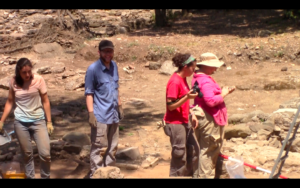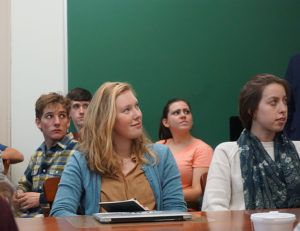By Allyn Waller ’18
This past summer, I had the privilege and the pleasure of working on an archaeological excavation at Poggio del Molino in central Italy. Along with two other Holy Cross students, Amanda Kondek ’17 and Eric Fox ’18, I spent several weeks kneeling on rocks, scraping dirt off of other dirt, discovering how much rock looks like pottery, and vice-versa.
A Day in the Life
On a typical day, we would get up early in the morning, eat breakfast, pack lunches and head to the dig site. Five minutes down a dirt road in between fields of grapes and we arrived at the site. After digging for a few hours, painstakingly scraping the dirt up one layer at a time, checking each object for archeological significance and brushing up the dust, we took a coffee break. After half an hour or so sitting in the shade, it was back to work again.

When we found something in the layer we were removing, we would carefully remove the dirt around it to determine if it was fully contained in the layer. If it was, we removed it and placed it in a bag for later cleaning and labeling. Unless, of course, it was actually a rock. Determining whether something was a rock or pottery sherd, however, was not always easy. “Is this rock or pottery?” was a constant refrain for the first few days, at least until one of the grad students at the site explained that we could always lick it and find out. (Apparently, since pottery is porous, it will stick to your tongue if you lick it.)

Eventually, it was time for lunch. (That is, if you weren’t full from licking rocks all morning.) During lunch, we had the opportunity to talk to the other people who were working on the site with us. Each week, there was a different group working with us on the dig. One week, it was a group of Italian high school students who were spending their summer trying out different jobs a week at a time, getting a feel for what they wanted to do. Another, it was a group of students from all over Europe and North America as part of a summer program in archaeology. For two weeks, we had a group of restoration experts working on the mosaics of the baths and bedrooms.
History
But Poggio del Molino was more than just a rich Roman’s mosaicked country retreat. It began, in fact, with pirates. The earliest structures we have evidence of at Poggio del Molino are three towers designed for defending the nearby Etruscan settlement of Populonia from pirates. Later, after the Roman republic controlled the area and mitigated the threat of piracy, the site became a factory for producing garum, a sauce made from pickling fish intestines.
During the Empire, as it became cheaper to produce garum in newly-acquired territories like North Africa, it was turned into a country villa for some wealthy Roman family. Sometime in Late Antiquity, the bedrooms of the villa were reconstructed into a small church by knocking all interior walls down and walling up the doorways.
Cool Finds
Due to this varied history, there were lots of really interesting things to be found at our site. Several bronze coins, ranging in size and preservation from a small speck just half the size of a pinky nail up to an inch-wide disc with legible writing and a clear profile were found in and around the area we worked in. We found evidence of iron-mongering operations, including leftover iron slag, hematite ore, and the burns left by furnaces on the floor. I found a small block of lead, which I thankfully recognized before anyone licked it. We found both bronze and iron nails, as well as some larger, but mostly unrecognizable, iron pieces.

We found pottery, of course. Most of it was fairly coarse cooking ware or simple dining or storage pottery, but I did find a fancy painted black-slipware piece from the fourth century BCE. Of course, the excitement from finding it was slightly marred by the fact that it should not have been there. I found it in the uppermost layer of soil, the humus, under the roots of a big pine tree. Chronologically, we should have been finding cassette tapes and floppy disks, not pottery pushing 2500 years.
That strangely located piece, however, has to contend with another for the best find of the summer: The Italian high school students working the room next to ours found a completely intact clay lamp! It looked as if it had just been pulled out from behind the glass in a museum display. It was absolutely incredible, although my expectations might have been slightly lowered by 87,492 things I had found that day that weren’t pottery, much less intact.
Of course, it wasn’t all kneeling on rocks and scraping dirt out of tree roots. On weekends we were free to take trips to various cities around Italy, so we saw a lot of museums (and gelaterias). To me, though, the most exciting museum was the one in the modern-day town of Populonia, where most of the collection came from Poggio del Molino. I like knowing that the things I excavated could end up in a museum someday, informing future Classicists. Increasing our knowledge about the world of around two thousand years ago is worth a little dirt-scraping and root-kneeling. But maybe not rock-licking.
Allyn, from Atlanta, Georgia, is a Classics major with a minor in Computer Science. He is also completing the Teacher Education Program at Holy Cross.




